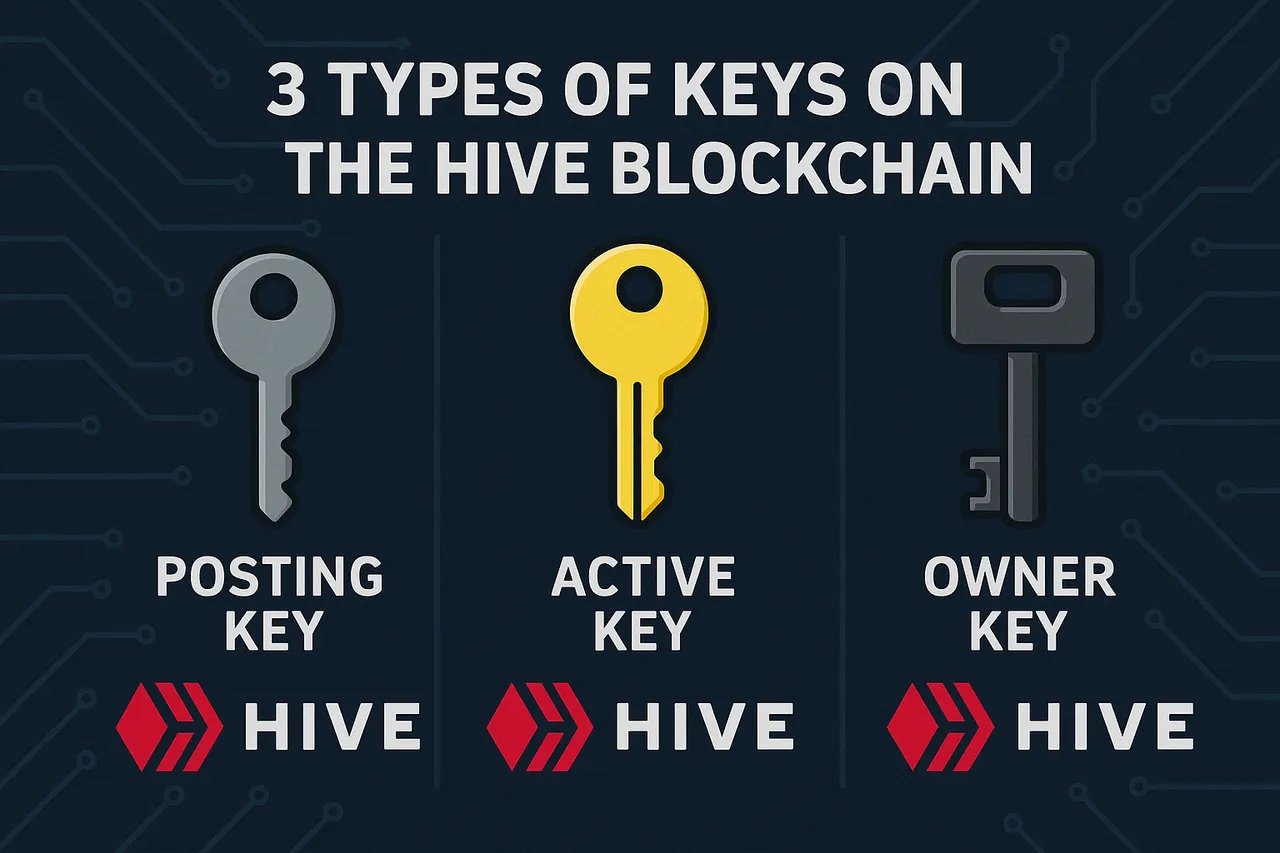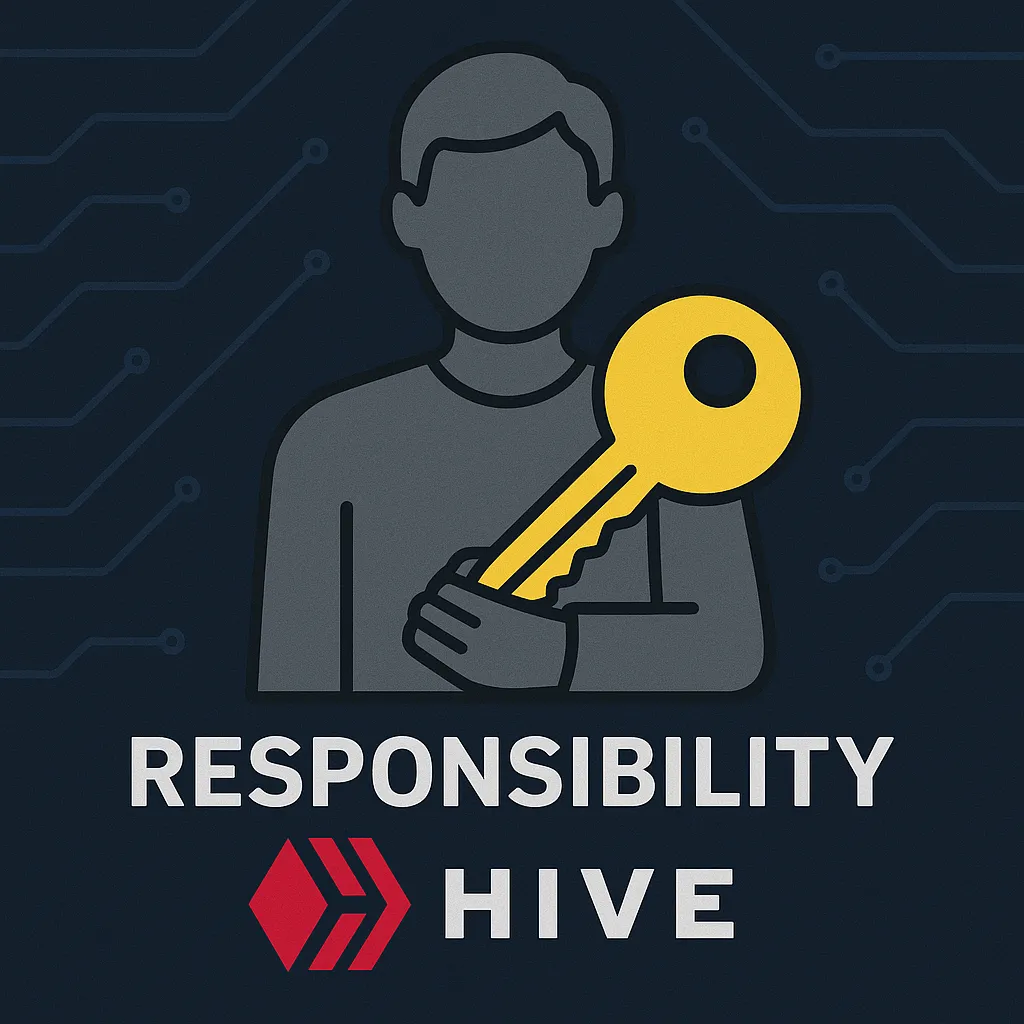
Wenn man sich mit HIVE beschäftigt, merkt man schnell, dass es hier nicht einfach nur ein Passwort gibt, sondern gleich mehrere sogenannte "Keys", also Schlüssel. Jeder dieser Schlüssel hat eine bestimmte Aufgabe und ist unterschiedlich wichtig – und genau deswegen sollte man sich mit dem Thema gut auseinandersetzen, bevor man einfach loslegt.

Ganz grob gesagt gibt es vier verschiedene Keys: Der Posting Key ist der, den man für den Alltag braucht. Mit ihm kann man Beiträge schreiben, voten oder kommentieren. Den kann man ruhig im Browser oder in der App speichern, solange man sicher ist, dass die Seite vertrauenswürdig ist.
Dann gibt es den Active Key. Der ist schon etwas sensibler, denn mit ihm kann man Hive versenden, Hive Power auf- oder abbauen oder interne Marktplätze nutzen. Diesen Key sollte man auf keinen Fall im Browser speichern oder leichtfertig irgendwo eingeben – nur dann, wenn man wirklich gerade eine Transaktion macht.
Der Owner Key ist der wichtigste und auch gleichzeitig der gefährlichste. Wer diesen Key hat, kann alles – auch alle anderen Keys zurücksetzen. Deshalb sollte man ihn nie im Alltag benutzen und ihn ausschließlich offline aufbewahren, z. B. auf Papier oder einem USB-Stick, am besten verschlüsselt. Wenn der weg ist und jemand ihn findet, ist der ganze Account in Gefahr.
Dann gibt’s noch den Memo Key, der wird eher selten gebraucht. Damit kann man verschlüsselte Nachrichten lesen, die z. B. bei einer Überweisung mitgesendet wurden.

Das große Thema bei den HIVE-Keys ist: Verantwortung. Es gibt keinen klassischen „Passwort vergessen“-Button. Wenn man seine Keys verliert, kommt man an nichts mehr ran – weder an den Account noch an das Guthaben. Und wenn jemand deinen Active oder Owner Key stiehlt, ist schlimmstenfalls alles weg. Es gibt keine zentrale Stelle, die das rückgängig machen kann.
Deshalb sollte man ganz bewusst entscheiden, welche Keys man wo nutzt. Am besten arbeitet man im Alltag nur mit dem Posting Key und lässt alle anderen gut gesichert in der Schublade oder im Passwortmanager. Wer ganz sicher gehen will, kann zusätzlich noch eine Wallet-App wie Hive Keychain verwenden – die übernimmt das sichere Verwalten der Keys, ohne dass man sie ständig eintippen muss.
Man merkt also: Die Sache mit den Keys ist am Anfang vielleicht etwas ungewohnt, aber sie ist total wichtig – und wenn man es einmal verstanden hat, gibt einem das System eine Menge Kontrolle und Sicherheit. Man muss nur vorsichtig sein, sich an ein paar Grundregeln halten – und am besten seine Keys niemals aus den Augen verlieren.

When you start working with HIVE, you quickly realize that there isn't just one password, but several so-called “keys.” Each of these keys has a specific function and varies in importance—which is precisely why you should familiarize yourself with the topic before you get started.

Roughly speaking, there are four different keys: The Posting Key is the one you need for everyday use. It allows you to write posts, vote, or comment. You can safely store it in your browser or app as long as you are sure that the site is trustworthy.
Then there is the active key. This is a bit more sensitive, because it can be used to send Hive, increase or decrease Hive Power, or use internal marketplaces. Under no circumstances should this key be stored in your browser or entered carelessly anywhere—only when you are actually making a transaction.
The Owner Key is the most important and also the most dangerous. Anyone who has this key can do anything – including resetting all other keys. That's why you should never use it in everyday life and only store it offline, e.g. on paper or a USB stick, preferably encrypted. If it goes missing and someone finds it, your entire account is at risk.
Then there is the Memo Key, which is rarely used. It can be used to read encrypted messages that were sent along with a transfer, for example.

The big issue with HIVE keys is responsibility. There is no traditional “forgot password” button. If you lose your keys, you can no longer access anything—neither your account nor your balance. And if someone steals your active or owner key, in the worst case scenario, everything is gone. There is no central authority that can reverse this.
That's why you should make a conscious decision about which keys to use and where. It's best to only use the posting key in everyday life and keep all the others safely stored in a drawer or password manager. If you want to be extra safe, you can also use a wallet app like Hive Keychain, which securely manages your keys without you having to type them in all the time.
So you see: the whole thing with keys may be a little unfamiliar at first, but it's really important – and once you understand it, the system gives you a lot of control and security. You just have to be careful, follow a few basic rules – and ideally never let your keys out of your sight.
